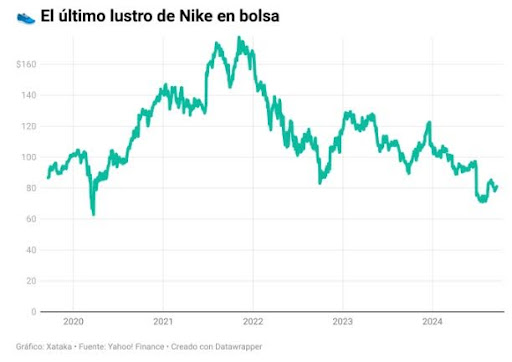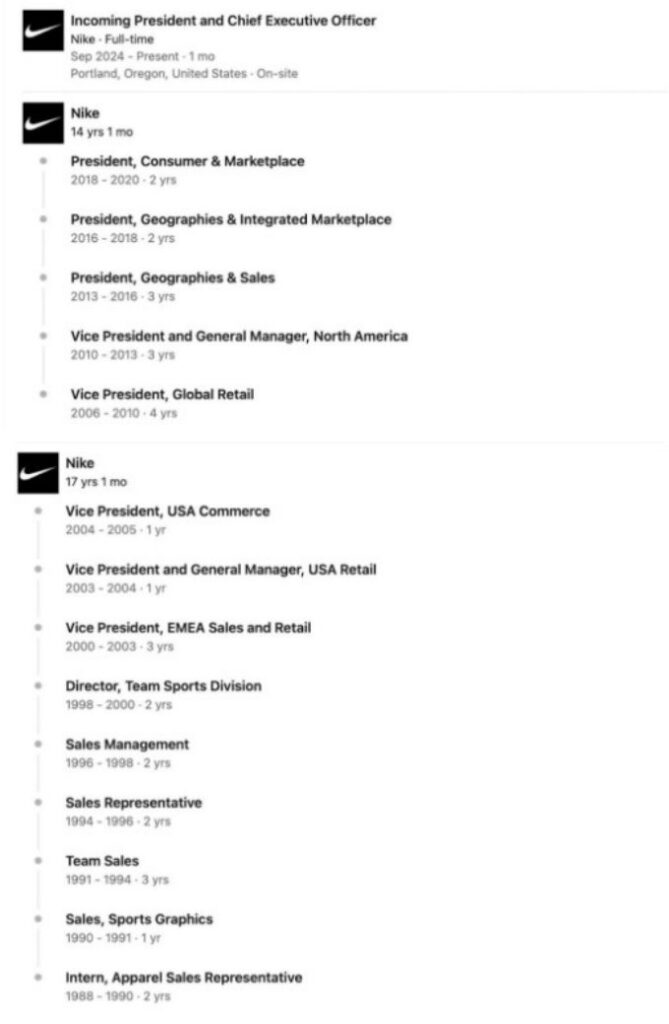Elliott Hill and Nike’s comeback: can the veteran save the brand?
October 3, 2024

Nike shocked the market by announcing that John Donahoe will step down as CEO, and Elliott Hill, a veteran with over 32 years at the company, will replace him starting October 14. This decision is no small matter: Hill is returning after four years of retirement at a critical moment for the world’s most iconic sports brand. The news had an immediate impact on the stock market: Nike’s shares, which had suffered a 25% drop this year, bounced back by 8.7% on the day of the announcement, reflecting investors’ optimism about Hill’s potential to restore the company’s stability and growth.

A challenging context for Nike
This appointment comes during a challenging period for Nike. In recent months, the company has faced several issues, including a 2% drop in sales in the last quarter and a projected 10% decline for the rest of the fiscal year. Moreover, since its peak in 2021, Nike’s stock has lost over 40% of its total value. Alarm bells rang when Nike announced that its annual revenues would decline for the first time in 20 years, leading to a sharp drop in its stock.
The value of internal talent
Elliott Hill is no stranger to Nike. His extensive resume within the company is a clear demonstration of the value Nike places on internal talent development. Hill began as an intern in 1988 and gradually rose to key roles, including Vice President of Sales, General Manager of North America, and President of Consumer & Marketplace. During his tenure, Hill was instrumental in expanding Nike’s presence in markets like China and North America, achieving a 60% increase in sales in just four years.
This type of trajectory not only reflects the trust Nike places in Hill but also highlights the importance the company assigns to internal experience and understanding of its corporate culture. A prime example of this is Hill’s success in driving the global expansion of the Jordan brand, which was crucial in establishing Nike as a world leader in athletic footwear. Hill is known for his ability to forge strong relationships with key figures, such as Michael Jordan, which helped maintain the brand’s momentum even during uncertain times.

Can Hill restore Nike’s essence?
Despite the optimism surrounding his return, Hill faces enormous challenges. John Donahoe’s strategy, focused on the direct-to-consumer (DTC) model, led Nike to cut ties with more than half of its retailers and rely heavily on online sales, especially during the pandemic. While this model was successful in its early stages, it left Nike vulnerable when consumers returned to physical stores, allowing competitors like Adidas, New Balance, and Hoka to gain market share in areas Nike had abandoned.
A lack of innovation is also a constant criticism. Iconic models like the Air Force 1, Jordan 1, and Dunks, which once dominated the market, have lost traction, and consumers are demanding newer and more disruptive products. Hill will need to focus on accelerating product development and reviving sneaker culture to reconnect with a younger audience that craves authenticity and creativity. In this sense, the pressure to deliver results will intensify at the upcoming Investor Day on November 19, where Hill will need to present a clear and compelling strategy for the company’s future.
However, in addition to the challenges, Hill’s return presents an interesting opportunity for Nike to reposition itself by leveraging one of the strongest trends in today’s market: valuable content and connection with digital communities. In an environment where brands must go beyond their products to generate relevance, Nike has the chance to establish a solid narrative that deeply resonates with its audiences. Hill could lead a strategy that uses content to convey authenticity and values, building long-term relationships with consumers who are looking for more than just sneakers—they seek experiences, stories, and a sense of belonging.
Nike’s ability to leverage well-established digital communities, such as sneakerheads, sports enthusiasts, and fitness lovers, is a key asset. These groups are ready to engage if provided with relevant and authentic content. If Hill seizes this opportunity and strengthens the brand narrative through platforms like TikTok, Instagram, and YouTube, Nike could not only reconnect with its traditional audience but also attract new generations, establishing a stronger base of loyalty. Here, the combination of authentic brand ambassadors and user-generated content will be crucial in revitalizing the emotional connection that once made Nike a cultural icon.
A new era or the last attempt?
Hill arrives with the backing of key figures such as Phil Knight, Nike’s co-founder, and Mark Parker, who described him as “the right person to lead Nike’s next stage of growth.” However, history shows us that leadership transitions at iconic companies are not always a guarantee of success. For Nike, the challenge will be to strike a balance between maintaining its legacy and adapting to an increasingly competitive and dynamic market. In this sense, the key may lie not only in product innovation but also in new content formats and communication methods.
By exploring new ways to generate loyalty and engagement—such as live content, influencer collaborations, or even real-time personalization—Hill has a unique opportunity to lead Nike into a new era of digital relevance. What happens in the coming months will define whether Elliott Hill will be remembered as Nike’s savior or if his return was merely a last attempt amid an unprecedented crisis. However, if Hill can capitalize on these opportunities, he could open the door to a resurgence based not only on sales but on a deeper emotional connection with Nike’s audience.




